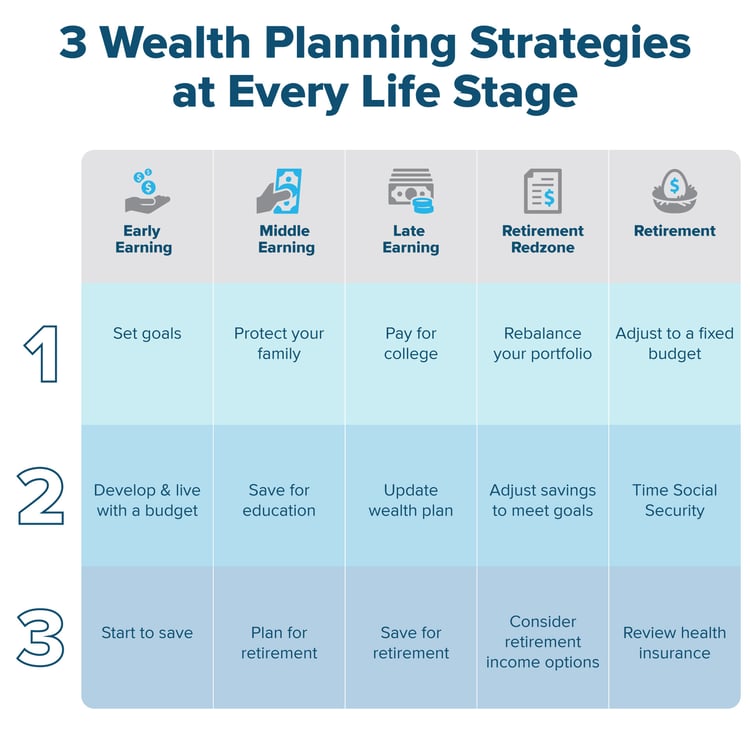Wouldn’t it be nice if retirement happened without fuss or bother? Better yet, if you had an automated assistant that took care of all of life’s financial challenges for you?
Each morning you would just log in and hear a report from your virtual assistant. “Today, I bought your life insurance and started your child’s college savings plan. I also rebalanced your investment portfolio. You are on track to retire at age 67 and 4 months.”
Let us know when you have that app!
In the meantime, here’s a checklist giving you key steps to take at each life stage, so you can possibly retire when you want and live the retirement of your dreams.
 Early earning years
Early earning years
The key in your early years is to develop good financial habits. Three important steps are 1) setting goals, 2) developing and living within a budget, and 3) starting to save.
What are your goals? You may be itching to travel the world, further your education, or buy a house. What you’re probably not thinking about early in your career is retirement. But you should be!
To achieve your goals, develop a monthly budget that covers living expenses. Include a debt payoff plan if you have outstanding loans. Then allocate the rest of your money towards saving for your goals. Because each will have a different time frame, you may need to separate your savings into various buckets. One bucket may be for a short-term goal of under five years, while another may be for a long-term objective of over 30 years.
For short-term money, consider saving it in a highly liquid account, such as in a money market fund. But for the longer-term assets, think about growing your money through stock investments.
Saving for retirement is included in the longer-term bucket. Start by participating in your company’s retirement plan—like a 401(k) or 403(b) plan. One of the benefits of an employer-sponsored retirement plan is that it automatically deducts your contribution each paycheck before you see it and invests it in the funds you choose. Some employers match a portion of your contributions—you should take advantage of free money. Left there to grow for decades, it could eventually help fund 30 years of retirement—potentially quite a large sum! But this is harder to do if you start later in life when you have fewer years to grow your money. So start early.
If your company doesn’t offer a retirement plan, or even if they do, you can contribute to an IRA. There are separate limits for IRAs and employer-sponsored plans, and having both may impact if you can benefit from a tax deduction. If you don’t have a company plan, a traditional IRA may allow you to take a tax deduction for the amount you contribute up to $6,500, while a Roth IRA does not provide a tax deduction for your contribution, but your money grows tax-free forever.
Middle earning years
As you get older and more established in your career, your income may rise, and your objectives may be starting a family and buying a house. Key steps at this stage are 1) protecting your family, 2) saving for education, and 3) planning for retirement.
Before you have kids, life insurance is not that important. But once you have dependents, we believe you need it. There are two basic types—term and whole life. Each has advantages and drawbacks, so seek an insurance professional to help you choose the best plan for your needs. When asked by our clients, we generally do not advocate for whole life based on its investment offerings. Instead, we believe direct investments in the market can be a better way to accumulate and grow wealth.
It’s also a good idea to start saving for your children’s education as soon as possible. Many people do this by opening a 529 plan. A 529 also has attractive tax advantages—for both contributions and withdrawals. Automatically contributing to it each month can help you save without actively thinking about it.
Finally, keep saving for retirement. We know this can get challenging, especially if you have a new mortgage on top of family expenses. But saving for your retirement is the best way to ensure you’re on financial footing for the later stages of your life. So allocate as much as you can—ideally, enough to take advantage of any company match offered, which may be 2% to 4% of your salary. That’s free money!
Late earning years
At this stage, both income and expenses will likely be near their highest level. The keys in these years are 1) paying for college, 2) updating your financial plans and investments, and 3) (surprise!) saving for retirement.
Take advantage of various ways to pay for your college. But here’s a word of advice: We recommend that (no matter how much you love your kids!) you do not sacrifice your retirement savings to fund their education. That may sound harsh but think about it like this: Your kids can take out a loan to pay for their education. You cannot take out a loan for your retirement. Unfortunately, individuals who forgo saving for retirement in lieu of paying for their kids’ education can end up dependent on them later in life. That is not a financial burden you want to place on your kids if you can avoid it.
Take time to review your wealth plan. Assess if you are on track with your retirement goals and make necessary adjustments to your savings amount, asset allocation, and time horizon.
The last item is to keep saving for retirement. Remember, set it, but don’t forget it. Review it at least annually.
The “red zone” before retirement
The five or so years before retirement are a time to make key adjustments. These include: 1) rebalancing your portfolio, 2) adjusting savings to meet goals, and 3) considering retirement income options.
At this point, your income is likely at its peak level, your extreme expenses (like college) are hopefully behind you, and you should be well on your way to funding your retirement. So, if you need to increase savings to meet your goals, now is the time.
Discuss with your financial planner if your retirement portfolio has the right asset allocation or if you should create a cash carve-out strategy. Many people choose to be less exposed to swings in the market (more conservative, less growth) at this stage, but they often forget that their retirement can span two or more decades.
So instead of moving towards a too-conservative portfolio allocation, perhaps consider setting aside three to five years’ worth of living expenses in a liquid portfolio—a cash-carve out—so you don’t have to worry about unforeseen expenses or a market downturn while the rest of your portfolio continues to grow. The key is to keep your portfolio growing while feeling confident that you can fund your expenses without having to sell during a market decline.
Some people consider whether they might benefit from an annuity in retirement. Annuities are insurance contracts between a buyer (annuity holder) and an insurance company. The buyer pays into an annuity today to receive a benefit in the future. But annuities require that you give up a portion of your money because they usually cap the benefit at a certain level in exchange for the guarantee that you’ll receive a monthly sum until you die. They’re also expensive. So, in the end, an annuity may force you to leave money on the table. We think there’s a better way to generate income in retirement. But for some individuals who are risk averse and want that guarantee, they might be a good fit.
Retirement
Key steps at this stage are 1) adjusting to a fixed budget and loss of income, 2) timing Social Security, and 3) reviewing your health insurance.
Retirement is what you’ve been working towards for most of your career. It’s an exciting time, but it’s also a big adjustment. Many people find the change in their daily routine difficult. Others also have trouble getting used to the loss of a steady income. As a result, some people prefer to work part-time in retirement. This keeps them busy, happy, and active while providing extra income.
As you enter your retirement years, you’ll need to decide when to access your Social Security benefits. You can first apply at age 62 but can wait until age 70 if you don’t need the income. There are some key considerations to think about. (Check out this report to learn more about when you should take Social Security.)
At the same time, you should re-evaluate and adjust your investment portfolio to meet income needs and growth objectives. Calculating your required minimum distributions (RMDs) from your 401(k) and traditional IRAs is part of the review.
Another important step at this stage is health insurance, possibly including long-term care insurance. Health care can become incredibly expensive in the last three to five years of life. Long-term care insurance may reduce that cost.
Planning is key at every stage
If you don’t already have a wealth advisor, consulting one at each life stage may make sense. This is especially true if you have difficulty establishing your goals and creating a roadmap to reach them. Your planner will help you get on track, make sure your investments are appropriate, and manage your investment behavior so you don’t react emotionally to swings in the market.
Related tags
Financial Planning Social Security Retirement Earning Years Retirement Red Zone Women & Investing
Like what you're reading?
Join the thousands of readers getting stories like this delivered straight to their inbox every Thursday — for free. Give it a spin, enter your email to sign up.
Related Articles

Wealth Planning for Empty Nesters
Wow, it’s been a couple of decades in the making. You've cuddled, fed, rough-housed, counseled,...

What’s the Difference Between a 401(k) and an IRA?
If you recently decided to start saving for retirement or you’re fine-tuning your approach, pat...

3 Wealth Planning Tips for the Self-Employed
If you are considering going out on your own, or you’re already your own boss, you are part of a...
